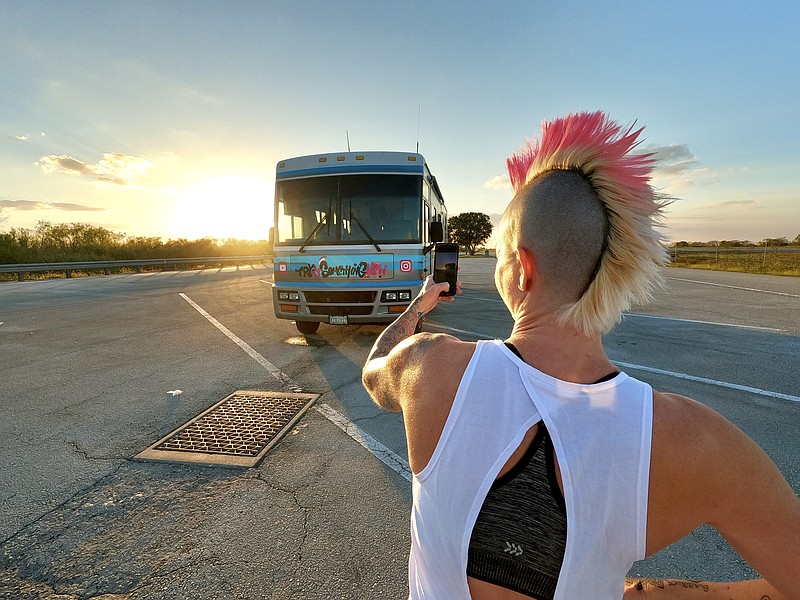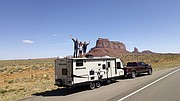Between canceled flights and closed borders, 2020 changed the way we vacation.
Meanwhile, the work-from-anywhere trend made us more mobile than ever.
Enter, the age of the RV.
Interest in recreational vehicles has been revving up in recent years, fueled by minimalist-loving millennials and retiring baby boomers, but last year the market exploded. Despite early pandemic shutdowns, RV dealers across America reported record sales, and for some companies, the demand has been overwhelming.
Located in Hohenwald, Tennessee, three hours northwest of Chattanooga, Oliver Travel Trailers is a family-owned manufacturing company, founded in 2007, that specializes in high-end, made-to-order trailers. Pre-pandemic, says Matt Duncan, director of marketing, the company employed about 50 people and sold about 15 trailers per month. Last May, following a six-week shutdown, Oliver reopened - and instantly nearly doubled its sales.
That May, it sold 26. In June, 42. July, 55. And sales have remained steady, Duncan says.
To keep up, Oliver hired 20 more employees and increased production from three trailers a week to seven.
Still, he says, "If you ordered an Oliver today, it wouldn't be delivered until December."
Winnebago, one of America's best-known RV brands, now has a 2-year waitlist.
So buckle up. The market is yet to show signs of slowing.
Here is a look at five RV types and trends helping drive America's free-wheeling fantasies.
^^^
Camper vans
Among the ever-expanding millennial market, camper vans have become the top choice. In fact, according to the RV Industry Association, last November, sales for these Class B motorhomes were up 125% - more than any other RV type.
Typically about 20 feet in length, the camper van is compact and easy to drive. Older, used models can be found for as little as $3,000. But the biggest factor contributing to camper vans' explosion on the scene: #vanlife, a social movement popularized through Instagram, lauding the nomadic lifestyle with an emphasis on experience over material possessions.
* Price range (new): $30,000-$125,000
* Most popular model: Mercedes Sprinter, starting at $36,355
>> As a result of the rise of the camper van, van conversion companies are also now exploding on the market. These third-party businesses help custom outfit vans for comfortable living. The cost for partial or full builds can range from $5,000 to $150,000. In Chattanooga, check out Site Seven, a local company specializing in camper van conversions of Mercedes-Benz Sprinters, Dodge Promasters and Ford Transit vans.
^^^
Lightweight tow-behinds
Small, single-axle tow-behinds are becoming more and more popular, and a favorite among millennials and Gen Xers. They tend to cost less, they're more fuel efficient, and most notably, they don't require a towing-specific vehicle. By replacing steel with aluminum and fiberglass, and bulky appliances with compact propane-powered ones, many of these models can be hauled with a compact pickup, midsize SUV or crossover.
In fact, some pop-up trailers, which feature tent-like walls and are easily collapsible, can be towed by a sedan. The SylvanSport Go, for example, made in Sylvan, North Carolina, is just 17 feet long and 840 pounds.
* Price range: $8,000-$23,000
* Crowd favorite: Forest River r-pod, starting at $24,000
^^^
Mobile office innovations
>> Airstream
In all its iconic, silver-bullet glory, the Airstream, first introduced in 1934, has withstood the test of time. Through the decades, it's remained a favorite among baby boomers, its primary demographic. But now, the Ohio-based company is working to broaden its appeal.
Enter the brand's new mid-range model. Based on its best-selling Flying Cloud model, the Flying Cloud 30FB Office features an office floor plan with a built-in desk, blackout curtains, USB ports for charging devices and options for mobile internet packages - designed especially with young professionals and home-schooling families in mind.
>> Connectivity
Remote work requires reliable cellphone and internet service, which is why many RV manufacturing companies now offer Wi-Fi and signal boosters as upgrade options. Attached to the RV's rooftop, these devices help strengthen cellular reception - a big benefit when frequenting remote campgrounds.
Moreover, RVs may even come with their own data plans, featuring hotspots to help with connectivity on the go.
^^^
RV sharing
Think Airbnb, but for RVs.
The rise of peer-to-peer online rental marketplaces is helping make RVs more accessible to those not ready to purchase. Companies such as Outdoorsy and RVshare let owners across the U.S. list or rent their rigs when not in use.
And 2020 - not surprisingly - was a record-setting year for such services.
Since its launch in 2015, Outdoorsy has seen a 400% increase in bookings. In 2020, between April and October alone, bookings increased by 4,600%, with 90% of those customers being first-time RV renters.
So, which models were the most popular among Outdoorsy's 2020 customers?
>> Most rented travel trailer: 2019 Jayco Jay Flight
The Jay Flight has been America's No. 1 best-selling travel trailer for more than a decade – so it makes sense that the model would be in abundance on a sharing service. Owners love it for its reasonable starting price, ranging from $31,000 to $40,000. And at 21-38 feet in length, it's perfect for towing the whole family.
>> Most rented motorhome: 2018 Thor Motor Coach Four Winds
Thor, meanwhile, is America's top-selling RV manufacturer, the owner of many well-known brands, including Jayco and Airstream. Ranging from 22-31 feet in length, its Four Winds model is one of its smaller motorhomes, making it easier to drive - which likely appeals to many first-timers. And despite its compactness, this RV packs a full kitchen, bathroom and multiple sleeping areas.

